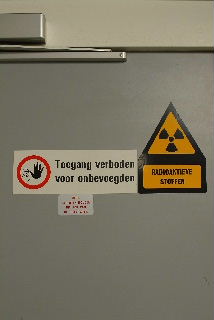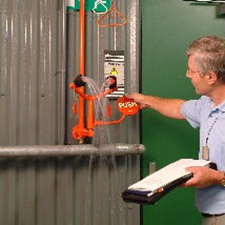Page content
Technische voorzieningen
Requirements for technical provisions

The following requirements apply to the technical provisions:
- Only work in rooms that are equipped for this purpose. Examples of these rooms are laboratories, preparation of cytostatics and cytostatic administration rooms, medicine rooms, radionuclide rooms, GMO rooms (ML laboratories), ORs, sterile units, technical workplaces, waste rooms.
- Classified laboratories, such as radionuclide, GMO, and microbiological laboratories, must be equipped with the appropriate warning signs on the entrance door.
- Within the laboratory, the storage place of the hazardous substances must be recognizable by a warning sign. A fire safety cabinet must have a flame pictogram on it.
- Carry out work with extremely toxic substances or carcinogenic mutagenic substances in specially designated (or sufficiently protected) areas. These rooms are only accessible for authorized employees.
- Always work in a properly functioning fume cupboard or use local extraction if dangerous gases, vapors, mists or dust may be released during work.
- Do not use recirculation of locally extracted air when handling substances with carcinogenic, mutagenic, or inhalation sensitizing properties.
- Keep doors closed as much as possible to avoid disturbing the air balance. In laboratories, the air management is set in such a way that air in the room is refreshed several times per hour. The laboratory remains in negative pressure compared to the corridor. If the door is left open, the negative pressure disappears and fumes and odors spread from the lab to the surrounding corridors. Short-circuiting air flows also affects the air exchange of the laboratory room. Doors must also remain closed because they are part of the fire resistance of a room. It is forbidden for radionuclides and GMO laboratories to leave their doors open.
- If there is a risk of leakage, work with drip trays.
Inspection and maintenance

Maintenance is important for a safe workplace to ensure optimal functioning of the equipment. Inform your supervisor when the following equipment needs inspection, maintenance or replacement:
- Equipment that handles hazardous substances
- Fume hoods
- Biological Safety Cabinets
- emergency showers
- Eye Washes
- Safety Features
- Safety aids and personal protective equipment
The supplier's manual explains how the equipment should function and what aspects need to be checked.
Fume hoods usually have an indicator light that indicates whether the ventilation is working. Therefore, have a broken indicator light bulb of a fume hood replaced immediately. Sometimes cabinets are equipped with a negative pressure gauge. A pennant placed at the rear flow bulkhead or a tissue at the window opening can also indicate whether the box is still working.
A (too) full arrangement in the cupboard, for example due to waste barrels, can seriously affect the operation.
A fume hood is not a storage place for hazardous substances. Objects in the fume cupboard can change the airflow in such a way that the protective effect of a fume cupboard is compromised. If you use a few hazardous substances in a fume cupboard every day, you can leave this limited workload in the laboratory's fume cupboard. However, make the risk assessment between taking the bottles back and forth to the safety cabinet every day and leaving them in the fume hood. If the safety cabinet is nearby, you can decide to store the bottles in it. Prevent the airflow over the fume cupboard worktop from being blocked by material inside the cabinet. Place bottles on an bench or a stand through which the air can flow.
Do not place residues of, for example, chloroform, phenol or alcohol in a fume cupboard to evaporate. Hazardous substances must be disposed of as such. This prevents emissions into the environment. Deliberately evaporating or flushing out hazardous substances if there are alternative disposal options is not permitted.
You can see how to use a fume hood correctly to prevent physical complaints in this video.
